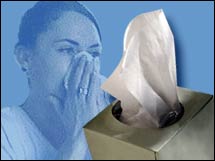Flu could cost employers $10 billionStudy shows sick employees could hinder the productivity of an entire company by spreading the illness.NEW YORK (CNNMoney.com) -- Employers should look out for common strains of influenza, which can quickly spread through an organization and severely damage the bottom line - to the tune of nearly $10 billion in paid sick leave nationwide, according a study released Monday by a global outplacement consultant. Challenger, Gray & Christmas Inc. said its estimate was based on government health statistics showing that 15 million to 60 million Americans get the flu each year, with as many as 70 million missed work days.
"The office is an ideal setting for the spread of the virus," said John A. Challenger, chief executive of Challenger, Gray & Christmas, in a press release. "For very small companies - with 20 or 30 employees, for example - there is always the risk that a flu outbreak can virtually shut down business for several days." There is a risk that sick employees could hinder the productivity of an entire department, although a flu outbreak may have a lesser impact on the bottom line of larger companies, according to Challenger. With median weekly earnings of $675 for all wage and salary workers, paid sick leave costs an employer $135 per day per employee. Challenger multiplied the $135 by the 70 million missed work days for a total of $9.45 billion in lost wages. "This estimate does not even account for decreased productivity, interruptions in customer service, lost sales, missed deadlines or the cost of hiring temporary workers," said Challenger. February could be the biggest month for workplace absences due to illness, according to records of flu activity from the Centers for Disease Control reported by Challenger. In nine of the last 21 years, February has been the peak month for reported cases of the flu. December has been the peak month in four of the last 21 flu seasons. Flu activity has peaked in January five times. "During the peak month, it is not out of the realm of possibility to have a large portion of a company's work force be stricken with the flu," said Challenger. Challenger recommends that companies take steps to prevent the spread of influenza among workers by urging employees to stay home when sick, providing free or subsidized flu shots, and improving nightly cleaning procedures. Employers should make an effort to make it easier for employees to work from home at the first sign of illness, the firm said. "It is when employees 'feel well enough to work' that they may be the biggest threat in terms of spreading their illness to others," said Challenger. "Companies do not want workers to skip work because of the sniffles, but they also cannot risk having an infected worker knocking out the rest of the staff." Challenger also said companies should also make sure that all employees have a basic understanding of other employee's job responsibilities, which can allow for a healthy co-worker to fill in when someone is out sick. "Both the employer and employee win," said Challenger. ---------------------------------------------------------------------------- |
|

